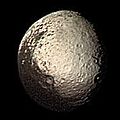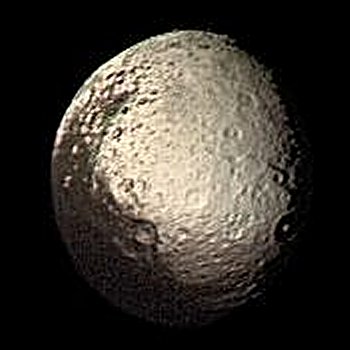Fexeiro:Iapetus by Voyager 2 - enhanced.jpg
Iapetus_by_Voyager_2_-_enhanced.jpg (350 × 350 píxeles, tamanho: 19 KB, tipo MIME: image/jpeg)
Stórico de l fexeiro
Clique an ua data/hora para ber l fexeiro tal cumo el staba naquel sfergante.
| Data i hora | Amostra | Tamanho | Outelizador | Comentairo | |
|---|---|---|---|---|---|
| atual | 17h29min de 4 de abril de 2005 |  | 350 × 350 (19 KB) | Smartech~commonswiki | *'''Iapetus by Voyager 2 spacecraft, August 22, 1981''' *same as Iapetus_by_Voyager_2.jpg but focused on the mooon and feature-enhanced. *original image caption: Saturn's outermost large moon, Iapetus, has a bright, heavily cratered icy terrain and a da |
Lhigaçones de l fexeiro
Esta páigina lhiga este fexeiro:
Outelizaçon global dun fexeiro
Las seguintes wikis outelizan este fexeiro:
- Outelizaçon na ar.wikipedia.org
- Outelizaçon na be-tarask.wikipedia.org
- Outelizaçon na be.wikipedia.org
- Outelizaçon na ca.wikipedia.org
- Outelizaçon na de.wikipedia.org
- Outelizaçon na el.wikipedia.org
- Outelizaçon na en.wikipedia.org
- Outelizaçon na eo.wikipedia.org
- Outelizaçon na es.wikipedia.org
- Outelizaçon na eu.wikipedia.org
- Outelizaçon na fr.wikipedia.org
- Outelizaçon na gl.wikipedia.org
- Outelizaçon na hr.wikipedia.org
- Outelizaçon na it.wikipedia.org
- Outelizaçon na ja.wikipedia.org
- Outelizaçon na ko.wikipedia.org
- Outelizaçon na la.wikipedia.org
- Outelizaçon na lb.wikipedia.org
- Outelizaçon na lt.wikipedia.org
- Outelizaçon na lv.wikipedia.org
- Outelizaçon na ms.wikipedia.org
- Outelizaçon na no.wikipedia.org
- Outelizaçon na pl.wikipedia.org
Ber la outelizaçon global deste fexeiro.




